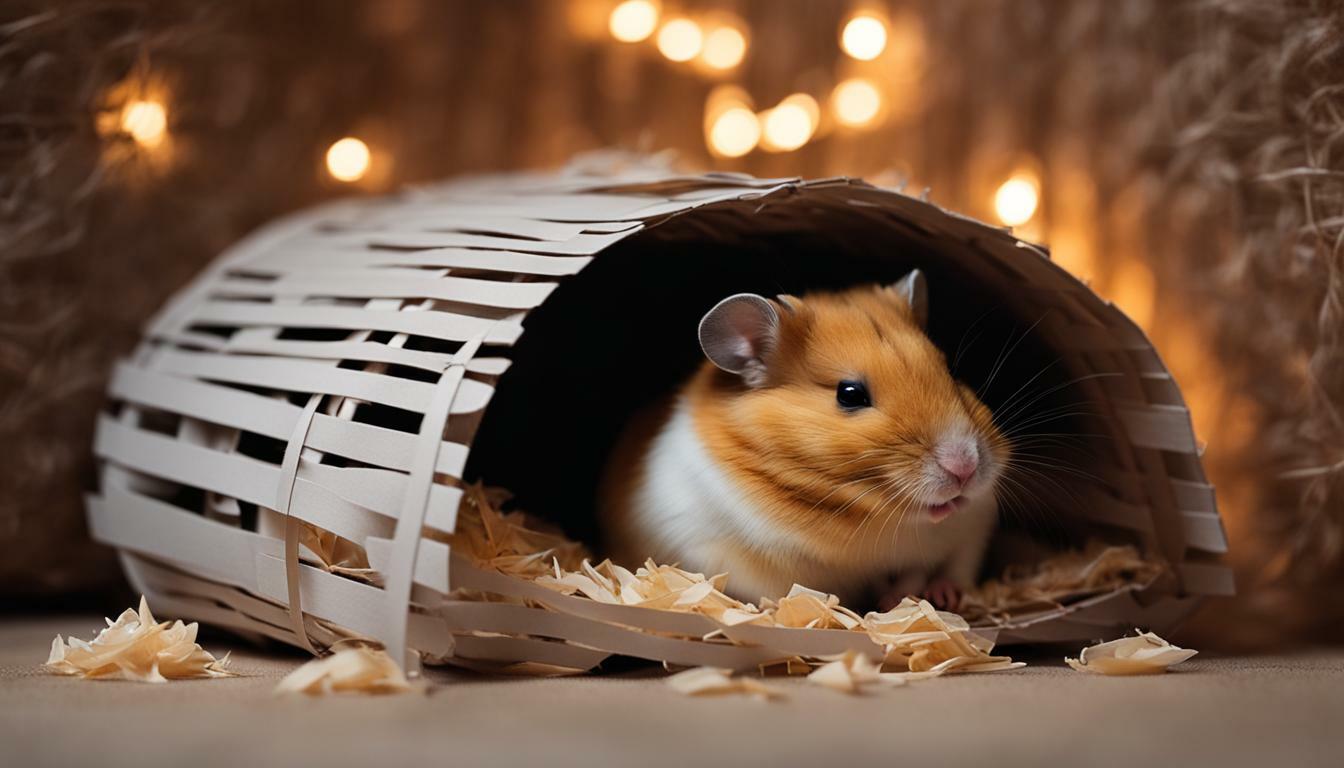Hamsters are known for sleeping a lot, but have you ever wondered why? Understanding their sleeping habits and patterns can provide valuable insights into their overall health and well-being. In this article, we will explore the reasons behind hamsters’ sleeping habits, their sleep patterns, and what excessive sleep may indicate. So let’s dive in and uncover the secrets of hamster sleep!
Key Takeaways:
- Hamsters require about 8 hours of sleep to remain healthy.
- If your hamster sleeps excessively, it could be a sign of torpor or an illness.
- Creating a safe and quiet sleep environment is crucial for your hamster’s well-being.
- Providing opportunities for exercise during their waking hours can help regulate their sleep routine.
- Consulting a veterinarian is important if you have concerns about your hamster’s sleep behavior.
Uncovering the Sleep Cycle of Hamsters
Hamsters have a distinct sleep cycle that differs from humans and other animals. Understanding their sleep behavior is essential for providing them with a healthy and comfortable environment. So, let’s explore the fascinating sleep cycle of these adorable creatures.
Hamsters are nocturnal animals, meaning they are most active during the night. Their sleep cycles consist of short periods of deep sleep followed by brief moments of wakefulness. This pattern is known as polyphasic sleep, and it allows them to remain alert and responsive to their surroundings even while sleeping.
During the day, hamsters will typically nap for shorter durations, usually in their burrows or cozy hiding spots. However, once night falls, they become active and engage in their natural behaviors, such as exploring, foraging, and exercising on their wheels. It’s important to provide them with a quiet and safe environment during their sleep hours to ensure they can rest undisturbed.
To promote a healthy sleep routine for your hamster, it’s crucial to respect their natural sleep cycle. Avoid disturbing or waking them while they are sleeping, as this can disrupt their sleep patterns and lead to stress or illness. Instead, create a peaceful setting for them with minimal noise and disturbances.
| Key Points: |
|---|
| Hamsters have a polyphasic sleep cycle, consisting of short periods of deep sleep and brief wakefulness. |
| They are nocturnal animals and are most active during the night. |
| Providing a quiet and safe sleeping environment is crucial for their well-being. |
By understanding and respecting the sleep cycle of your hamster, you can ensure they get the rest they need to stay healthy and happy. Remember, they need approximately 8 hours of sleep per day to maintain their optimal well-being. If you notice any signs of excessive sleep or abnormal behavior, it’s always a good idea to consult a veterinarian for guidance and support.
Factors Affecting Hamster Sleep
Several factors can influence the sleep patterns of hamsters. Understanding these factors is crucial for ensuring that your furry friend gets the rest they need to stay healthy and happy.
Environment: The environment in which your hamster sleeps plays a significant role in their sleep quality. Hamsters are sensitive to light, noise, and temperature changes. It’s important to create a safe and quiet space for them to sleep, away from any disturbances that could disrupt their rest.
Temperature: Hamsters are susceptible to temperature extremes. A hot or cold environment can disturb their sleep. It’s essential to keep their habitat at a comfortable temperature, ideally between 65°F and 75°F (18°C to 24°C), to ensure they can sleep soundly.
Health Conditions: Illness or discomfort can affect a hamster’s sleep patterns. If you notice that your hamster is sleeping excessively or showing changes in their behavior, it may be a sign of an underlying health issue. It’s crucial to observe their eating, drinking, and bathroom habits to monitor their overall well-being. If you have any concerns, it’s always best to consult a veterinarian.
| Factors Affecting Hamster Sleep | Recommendations |
|---|---|
| Environment | Create a safe, quiet space for your hamster to sleep away from disturbances. |
| Temperature | Maintain the habitat at a comfortable temperature, between 65°F and 75°F (18°C to 24°C). |
| Health Conditions | Monitor your hamster’s behavior and consult a vet if you notice any changes in sleep patterns or overall well-being. |
By considering these factors, you can help ensure that your hamster has a conducive sleep environment and maintain their overall health and well-being. Remember to respect their sleep schedule and provide opportunities for exercise during their active hours. By taking good care of your hamster’s sleep, you are contributing to their overall happiness and contentment.
Understanding Hamster Hibernation
Hamsters have a unique ability to enter a hibernation-like state in certain conditions. This state, known as torpor, is a natural response to a cold environment. When temperatures drop below a certain threshold, typically around 40°F (5°C), hamsters may enter torpor to conserve energy and survive harsh conditions.
During torpor, hamsters lower their metabolic rate and enter a deep sleep-like state. Their body temperature drops, their breathing slows, and they become less active. This hibernation-like state allows them to conserve energy and survive in cold environments where food and resources may be scarce.
It’s important to note that not all hamsters will enter torpor, and some species are more prone to hibernation-like behavior than others. Syrian hamsters, for example, are less likely to enter torpor compared to other species. Additionally, torpor in hamsters is different from the prolonged hibernation observed in animals like bears. Hamsters in torpor can wake up and become active if the environment warms up or if they are disturbed.
| Signs of Hamster Torpor | Cautionary Measures |
|---|---|
| – Cold to the touch | – Ensure a warm environment for your hamster |
| – Slow or shallow breathing | – Gradually raise the temperature in the hamster’s habitat |
| – Reduced activity and movement | – Offer warm bedding materials, such as fleece, for added insulation |
If you suspect that your hamster is entering torpor, it’s important to take preventive measures to ensure their well-being. Gradually raising the temperature in their habitat, offering warm bedding materials, and providing extra food and water can help alleviate the effects of torpor. However, it’s crucial to consult a veterinarian for guidance to ensure the proper care and health of your hamster.
How Much Sleep Do Hamsters Need?
To ensure their well-being, hamsters require a specific amount of sleep each day. These small creatures are most active during the night and tend to sleep for several hours during the day. On average, hamsters need about 8 hours of sleep to maintain their optimal health.
Sleeping too much, however, can be a cause for concern. If your hamster is consistently sleeping for extended periods of time, it could be a sign of torpor, which is a hibernation-like state. Torpor can be triggered by a cold environment, so make sure your hamster’s habitat is kept at an appropriate temperature. Excessive sleep can also indicate an underlying illness, so it’s important to monitor your hamster’s behavior and consult a veterinarian if needed.
Respecting your hamster’s sleep schedule is crucial. It’s best not to disturb them while they are sleeping, as this can lead to stress and disrupted sleep patterns. Creating a safe and quiet environment for your hamster to sleep in is essential. Avoid loud noises, bright lights, and disturbances during their designated sleep time.
| Hamster Sleep Tips: |
|---|
| – Provide a cozy, comfortable sleeping area in their habitat. |
| – Keep the environment calm and free from noise or sudden movements. |
| – Ensure a consistent sleep schedule by providing a quiet, dimly lit space during the day. |
| – Monitor your hamster’s sleep patterns and behavior for any changes or signs of illness. |
In addition to creating a conducive sleep environment, it’s important to provide opportunities for exercise and mental stimulation during your hamster’s waking hours. Regular exercise can help regulate their sleep behavior and promote a healthy sleep routine. Introduce toys, tunnels, and exercise wheels into their habitat to keep them engaged and active.
Signs of Excessive Sleep in Hamsters
While hamsters do sleep a lot, excessive sleep may be a cause for concern. It’s important to be aware of the signs that indicate your hamster may be sleeping too much. One common sign is if your hamster is consistently sleeping during their active hours, which are typically at night. If you notice that your hamster is not engaging in their usual activities, such as running on their wheel or exploring their habitat, it could be a sign of excessive sleep.
Another sign to watch out for is if your hamster is difficult to wake up or seems lethargic when they are awake. Normal sleep cycles for hamsters involve periods of deep sleep and lighter sleep, during which they may be more responsive to external stimuli. If your hamster appears overly drowsy or unresponsive, it could be an indication that they are sleeping too much.
Excessive sleep in hamsters can be caused by various factors, including illness or a cold environment. If your hamster’s habitat is too cold, they may enter a torpor state, which is a hibernation-like state where their metabolism slows down. In this state, hamsters may sleep excessively to conserve energy. It’s important to monitor the temperature in your hamster’s habitat and make sure it’s within the recommended range of 65-75 degrees Fahrenheit. If the temperature drops too low, your hamster may enter torpor and sleep excessively.
If you notice any signs of excessive sleep in your hamster, it’s essential to consult a veterinarian. Excessive sleep can be a symptom of an underlying health issue, such as an infection or an organ dysfunction. A vet will be able to assess your hamster’s condition and provide appropriate treatment. Remember, it’s best to respect your hamster’s sleep schedule and not disturb them while they’re sleeping. Creating a safe and quiet environment for your hamster to sleep in is important, and providing opportunities for exercise during their waking hours can help maintain a healthy sleep routine.
Ensuring Your Hamster’s Sleep Environment
Providing the right sleep environment is crucial for your hamster’s overall well-being. Hamsters are nocturnal animals, meaning they are most active at night and require several hours of uninterrupted sleep during the day. Here are some tips to create a safe and peaceful sleep environment for your furry friend:
- Choose a quiet location: Place your hamster’s cage in a quiet area of your home, away from noisy appliances or high-traffic areas. This will help minimize disturbances and provide a peaceful environment for sleep.
- Control the lighting: Hamsters are sensitive to light, so it’s important to keep their sleep area dimly lit during the day. Covering the cage with a towel or using blackout curtains can help create a dark and cozy atmosphere for your hamster to sleep.
- Maintain a comfortable temperature: Hamsters are sensitive to extreme temperatures. Keep their sleep area between 65-75°F (18-24°C) to ensure they can rest comfortably. Avoid placing their cage near drafts or direct sunlight.
- Provide a cozy sleeping spot: Hamsters love to burrow and nest, so it’s essential to provide them with a cozy sleeping spot. Line their cage with soft bedding material, such as shredded paper or aspen shavings, and include a small hideout or nest box for them to snuggle into.
Remember to respect your hamster’s sleep schedule and avoid disturbing them while they’re sleeping. They need uninterrupted rest to maintain their health and well-being. By creating a safe and quiet sleep environment, you can ensure your hamster gets the quality sleep they need to thrive.
| Tip | Description |
|---|---|
| Choose a quiet location | Place the cage in a quiet area away from noise |
| Control the lighting | Create a dimly lit sleep area with curtains or towels |
| Maintain a comfortable temperature | Keep the sleep area between 65-75°F (18-24°C) |
| Provide a cozy sleeping spot | Use soft bedding material and include a hideout or nest box |
Monitoring and Maintaining a Healthy Sleep Routine
Regularly monitoring your hamster’s sleep patterns is essential to maintain their health and happiness. As nocturnal animals, hamsters are most active during the night, which means they need adequate sleep during the day to stay active and alert. On average, hamsters require about 8 hours of sleep to remain healthy.
If you notice that your hamster is sleeping excessively, it may be a sign of torpor, a hibernation-like state that can be triggered by a cold environment. To prevent this, ensure that your hamster’s sleeping area is warm and comfortable. Use cozy bedding materials and keep their cage away from drafts. If you suspect that your hamster is in torpor, gently warm them up by covering their cage with a blanket or using a safe heat source like a heating pad.
Excessive sleep can also be an indication of illness, so it’s important to pay attention to your hamster’s behavior. Keep an eye out for other signs of illness such as loss of appetite, weight loss, or changes in activity levels. If you have concerns about your hamster’s sleep patterns or notice any abnormalities, it’s best to consult a veterinarian who specializes in small animals.
In order to maintain a healthy sleep routine for your hamster, it’s important to respect their natural sleep schedule. Avoid disturbing your hamster while they are sleeping, as this can disrupt their sleep patterns and cause stress. Creating a safe and quiet environment for them to sleep in is crucial. Ensure that their cage is placed in a peaceful area of your home, away from loud noises and excessive light.
Additionally, providing opportunities for exercise during your hamster’s waking hours can help regulate their sleep behavior. Hamsters are active creatures and need regular physical activity to stay happy and healthy. Invest in hamster toys, such as wheels or tunnels, to keep them entertained and promote exercise. Just make sure that the toys are suitable for your hamster’s size and breed.
Summary:
Regularly monitoring your hamster’s sleep patterns is vital for their overall health and happiness. Hamsters require about 8 hours of sleep to remain healthy, and excessive sleep can indicate a cold environment or an underlying illness. Create a warm and comfortable sleeping area for your hamster, and consult a veterinarian if you have any concerns. Respect their sleep schedule, provide a quiet environment, and offer opportunities for exercise during their waking hours to maintain a healthy sleep routine.
| Sleep Routine Tips | Benefits |
|---|---|
| Monitor sleep patterns | Ensure overall well-being |
| Keep sleeping area warm | Prevent torpor |
| Watch for signs of illness | Prompt veterinary care if needed |
| Respect sleep schedule | Reduce stress and disruption |
| Provide a quiet environment | Enhance sleep quality |
| Promote exercise during waking hours | Maintain a healthy sleep routine |
Hamster Sleeping Tips for Owners
As a hamster owner, there are steps you can take to support your hamster’s sleep routine. Hamsters are nocturnal creatures, meaning they are most active at night and sleep for several hours during the day. Providing a safe and quiet environment for your hamster to sleep in is crucial. Ensure their cage is placed in a peaceful area of your home, away from excessive noise and disturbances.
It’s important to respect your hamster’s sleep schedule and not disturb them while they’re sleeping. Hamsters are sensitive to light, so be mindful of keeping the room dimly lit during their sleeping hours. Avoid sudden loud noises or movements that may startle them awake. By creating a calm atmosphere, you can help your hamster get the restful sleep they need.
Creating a Sleep-friendly Habitat
In addition to a peaceful environment, it’s essential to provide your hamster with a comfortable sleeping space. Line their cage with soft bedding material that allows them to burrow and nest. Shredded paper or aspen shavings are good options. Avoid using materials like cedar or pine, as they can be harmful to hamsters’ respiratory systems.
Offering a cozy hiding spot, such as a small enclosed hut or a tunnel, can give your hamster a sense of security while they sleep. This will help create a sleep-friendly habitat that mimics their natural burrowing instincts. Regularly clean and maintain their sleeping area to ensure hygiene and prevent any odors that may disrupt their sleep.
Furthermore, providing opportunities for exercise during your hamster’s waking hours can help maintain a healthy sleep routine. Hamsters need mental and physical stimulation to stay active and alert. Place toys, tunnels, and exercise wheels in their cage to encourage movement. This will help expend their energy and promote a more restful sleep at night.
By following these hamster sleeping tips, you can support your pet’s sleep routine and ensure they get the rest they need to stay healthy and happy.
| Hamster Sleeping Tips for Owners |
|---|
| Create a peaceful environment |
| Keep the room dimly lit during sleep hours |
| Avoid disturbances or sudden noises |
| Provide soft bedding material |
| Give your hamster a cozy hiding spot |
| Offer toys and exercise equipment for stimulation |
Promoting Exercise During Wakeful Hours
Regular exercise can play a significant role in maintaining a healthy sleep routine for your hamster. Like any active pet, hamsters need opportunities to burn off energy and engage in physical activity during their waking hours. Incorporating exercise into your hamster’s daily routine can not only help regulate their sleep behavior but also contribute to their overall well-being.
One way to promote exercise is by providing your hamster with a suitable exercise wheel. Hamsters are known for their love of running, and an exercise wheel can provide them with an outlet for their natural instincts. Ensure that the wheel is the appropriate size for your hamster and is made of safe materials. Place it in their enclosure, allowing them easy access to it whenever they are awake.
In addition to an exercise wheel, consider offering your hamster a variety of toys and tunnels to explore. These can stimulate their curiosity and encourage physical activity. Rotate the toys regularly to keep your hamster engaged and prevent boredom.
| Exercise Tips for Hamsters: |
|---|
| 1. Set up an exercise wheel in their enclosure. |
| 2. Provide a variety of toys and tunnels for exploration. |
| 3. Allow supervised playtime outside the enclosure in a safe and secure area. |
| 4. Create obstacle courses using safe and hamster-friendly materials. |
Supervised playtime outside of the enclosure can also be beneficial for your hamster. Set up a safe and secure area where they can explore and interact with you. Ensure there are no hazards present, such as electrical cords or small objects that your hamster could ingest. Always supervise your hamster during playtime to prevent any accidents.
Incorporating exercise into your hamster’s routine can help them expend energy, stay mentally stimulated, and regulate their sleep patterns. However, it’s important to remember that each hamster is unique, and their exercise needs may vary. Observe your hamster’s behavior and adjust their exercise routine accordingly. By providing them with opportunities for physical activity, you can help promote a healthy sleep routine for your furry friend.
Section 11: Consulting a Vet for Concerns
If you have any concerns about your hamster’s sleep patterns, it’s best to seek professional advice from a veterinarian. Hamsters, like any other pet, can experience sleep-related issues that may require medical attention. By consulting a vet, you can ensure that your furry friend receives the necessary care and treatment.
A vet will be able to assess your hamster’s sleep behavior and determine if there are any underlying health issues causing abnormal sleep patterns. They may ask you questions about your hamster’s sleep duration, any changes in their sleep habits, and other behavioral indicators that can help identify potential problems.
During the examination, the vet may also perform tests to rule out any medical conditions that could be affecting your hamster’s sleep, such as respiratory infections or parasites. They will provide expert guidance on how to manage and improve your hamster’s sleep routine, ensuring their overall well-being.
| Benefits of Consulting a Vet for Hamster Sleep Concerns |
|---|
| Expert advice and guidance |
| Accurate diagnosis of potential health issues |
| Customized treatment plan tailored to your hamster’s needs |
| Peace of mind knowing you’re doing what’s best for your furry friend |
Remember, your hamster’s sleep is crucial for their overall health and well-being. By consulting a vet, you can address any concerns and ensure your hamster receives the necessary care to maintain a healthy sleep routine.
Conclusion
By understanding the sleeping habits and hibernation tendencies of hamsters, you can ensure their optimal health and happiness.
Hamsters are known for their sleeping habits, often snoozing for several hours a day. It’s important to respect their sleep schedule and not disturb them while they’re resting. They are most active at night, which means they require a quiet and safe environment to sleep in during the day.
On average, hamsters need about 8 hours of sleep to stay healthy. Sleeping too much, however, can be a sign of torpor, a hibernation-like state that hamsters enter when they are exposed to cold temperatures. In this state, their metabolism slows down, and they conserve energy. If your hamster is sleeping excessively, it might be worth checking if their sleeping area is too cold.
Excessive sleep can also indicate an underlying illness. If you notice your hamster sleeping more than usual or displaying other abnormal behavior, it’s important to monitor them closely and consult a veterinarian if necessary. A vet can help identify any potential health issues and provide appropriate treatment.
Creating a suitable sleep environment for your hamster is crucial. Ensure their cage is warm, quiet, and free from any disturbances. Providing them with a cozy sleeping area, such as a nest or hideout, can also contribute to their overall sleep quality.
In addition to a proper sleep environment, it’s essential to promote exercise during your hamster’s waking hours. Providing them with opportunities to explore, play, and exercise will help regulate their sleep behavior. A well-exercised hamster is more likely to have a restful sleep and maintain a healthy sleep routine.
By understanding hamsters’ sleeping habits and hibernation tendencies, you can ensure they lead a happy and healthy life. By monitoring their sleep patterns, creating a suitable sleep environment, and promoting regular exercise, you can help your furry friend enjoy a good night’s sleep and wake up refreshed and ready to play.
FAQ
Why do hamsters sleep so much?
Hamsters sleep for several hours a day and are most active at night. They require about 8 hours of sleep to remain healthy.
What does excessive sleep in hamsters indicate?
Excessive sleep can be a sign of torpor, a hibernation-like state caused by a cold environment, or an illness. It’s important to monitor your hamster’s behavior and consult a vet if necessary.
How should I respect my hamster’s sleep schedule?
It’s best to not disturb your hamster while they’re sleeping. Creating a safe and quiet environment for them to sleep in is important.
How can I provide exercise opportunities for my hamster?
During their waking hours, provide opportunities for exercise to help maintain a healthy sleep routine for your hamster.




